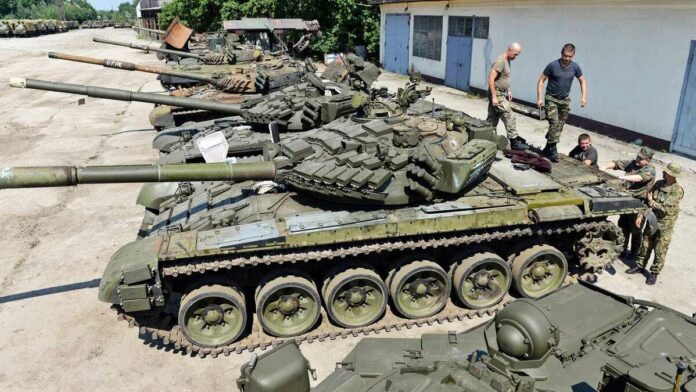T-72 is the main battle tank of the Russian Armed Forces. Since the Russian invasion of Ukraine, there was a lot of discussion about general performance of the tanks as the concept. And the main reason for this discussion was in particular the very poor performance of T-72 on the battlefield. But the real question is following – is it actually the tank’s fault? Or is it just Russian generals being incompetent? Let’s try to find out
Brief history of T-72
T-72 was developed for the only Russian tank factory that still has the capacity to produce tanks from scratch – UralVagonZavod. The story behind it is actually kind of funny. It started with T-64 tank which was developed in Kharkiv (modern day Ukraine). The tank was an Armata of its time – miles ahead any of its potential counterparts. It featured some absolutely revolutionary features, including combined armor and auto-loader.

The tanks was quickly adopted by the Soviet Army and the mass production started as soon as it was possible. Kharkiv Malishev Tank Plant could produce a decent number of them, but the Soviets wanted to produce these tanks on all available factories within the USSR.
But T-64 turned out to be too complicated for UralVagon plant. Especially it’s engine. For that reasons a simplified version of it was engineered. It entered the service as T-72 “Ural”, but was shortly upgraded to T-72A and T-72B versions.

The tank was produced from 1974 until 1992 on both UralVagon and Chelyabinsk tractor factory. Over 20000 vehicles were produced by the Soviet Union. The production discontinued after the collapse of the Soviet Union.
Further modernization of T-72
After the collapse of the Soviet Union, Russian Army was left with thousands of tanks of different modifications. This included such really outdated ones – T-55 and T-62. A big number of T-64 was also present at storage and at some regiments. Given that the main production plants for T-72 stayed inside the RusFed territory, the Armed forces made the right decision to focus on using T-72 tanks in most of the regiments, abandoning the rest by exporting them or putting in storage.
Two notable exceptions are T-80 and T-62. There are good reasons for Russian Army to use them, but we will talk about it in separate articles which will be linked to this one shortly.

In the 1990s and 2000s Russian government was dreaming of rearming their forces with “new” T-90 tanks. The irony is that T-90 is just a glorified T-72, without any major differences. Yet again, we will talk about this in a separate article.
After realizing, that the Russian economy cannot afford rearming with T-90 tanks, it was decided to modify existing fleet. Funny enough, the official reason for applying modifications was “to keep tanks up to date until T-14 Armata will start being mass produced”. As of early 2023, no mass production of Armatas started.

Anyway, in 2011 Russians started to modernize their tank fleet. This modification got the official designation of T-72B3. In terms of capabilities it is on the same level as T-90A. Which further shows how undeveloped T-90 in fact is, and here is why.
To upgrade regular T-72B to T-72B3 following procedures had to be done:
- Installation of new optics.
- Thermals from Thales Industries
- Night vision scope upgraded to Gen2
- New trucks
- New engine (on some tanks)
- Upgraded main gun
All these upgrades definitely made this tank stand out against an old T-72B. However, such things as “new trucks” and “upgraded main gun” seem to be almost negligible. It is very likely that they were only upgraded on paper – for corruption purposes.

It is also wise to note the modernization cost for each tank was around 2 million US Dollars. More than half of these funds were spend on doing a capital repair of the vehicle, rather than on the actual modernization. And this opened huge corruption opportunities between the Ministry of Defense and the Tank plant, which was doing the work. Make no mistake – Russians never miss such an opportunity.
So is it a good or a bad tank?
Despite the popular myth, Russian tanks are not better if the number behind the “T” is bigger. The fact is, that T-64, T-72, T-80 and T-90 are essentially have the same design and most of the main parts.
What is actually important are the indexes behind the numbers. A T-64BV (m.2017) is better than T-80BV or T-90A, for example. This mainly defines how modern the tank is – especially in terms of electronics.
Russia succeeded in modernizing a good chunk of their tank fleet to T-72B3 version. Given that we know their losses, it is safe to say, that around 40% were non-modernized unprepared Soviet T-72B, while the rest of the tanks were more or less modern T-72B3 of different modifications. This statistics is even more tricky, given that the Russian fleet of IFVs and APCs consisted mostly of Soviet made equipment – over 80%. BMP-3 and BTR-82 were the only “modern” vehicles.
However, the modern Russian modernization of T-72 were still lagging behind in terms of electronics. The fire control system, situational awareness program and the night vision scopes are all on the same level which was acceptable in the Western Armies in late 90s.
On top of that, all these devices installed on tanks, while certainly needed, aren’t capable of dealing with tank’s generational problems. And they certainly can’t deal with the stupidity of Russian officers.













